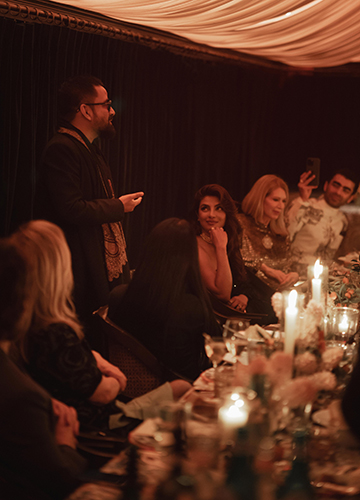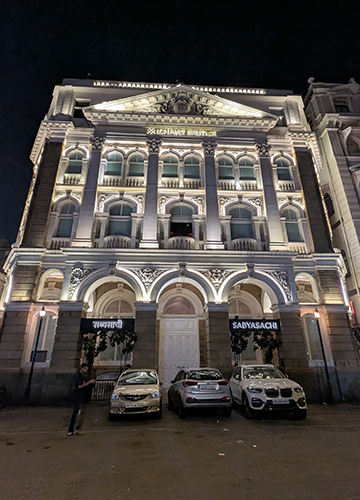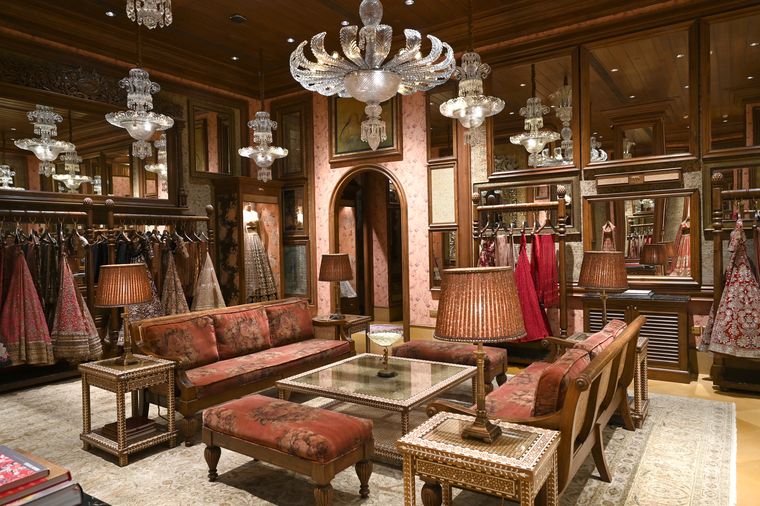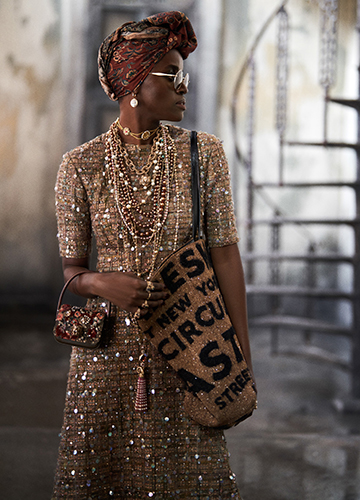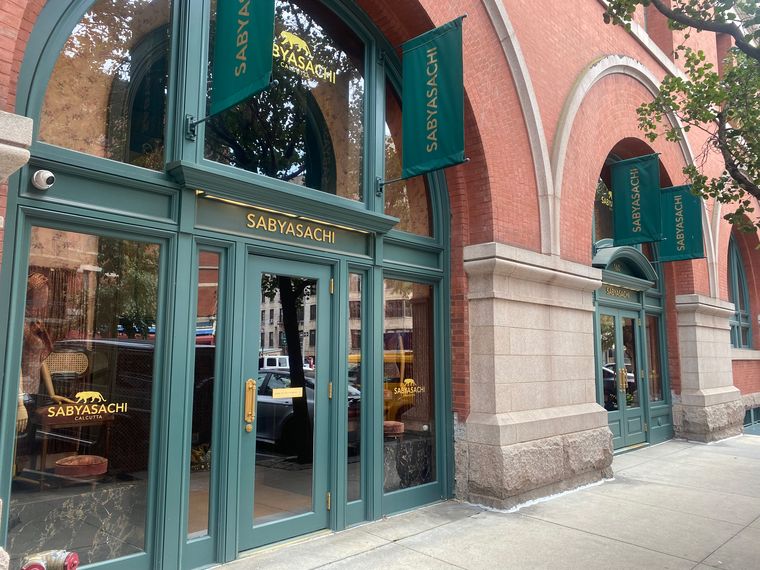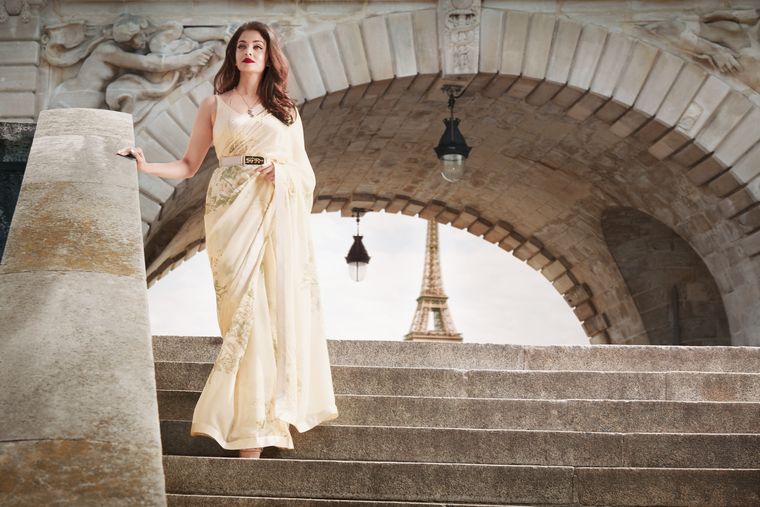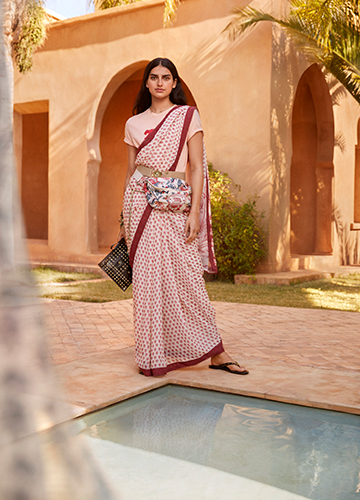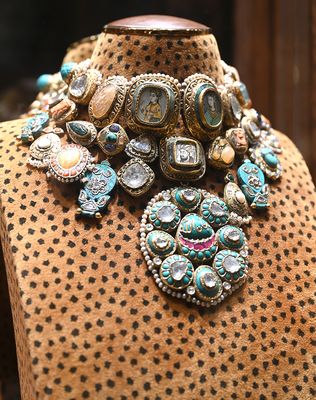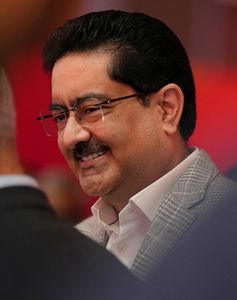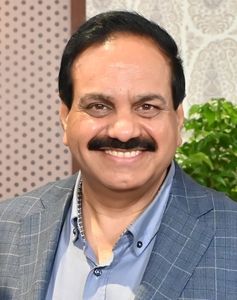I’m going to tell you a story no more than five people in the Indian fashion industry know. In 2015, as part of Lakme Fashion Week’s advisory board, I had suggested keeping the opening show for a Mumbai designer instead of one of the celebrity names from Delhi. These were the days when Lakme and Fashion Design Council of India (FDCI) had split, and the industry was cleaved into two. A month before the show, the Mumbai designer callously called saying he wanted to opt out. The organisers were in a fix. Who would they find to create 50 spectacular garments in 30 days and put together a theatrical show? They called Sabyasachi Mukherjee.
Those days the fashion week would offer a designer Rs25 lakh to put together the show. Mukherjee added Rs40 lakh of his own, and gave Mumbai the most beautiful fashion show it had ever seen. The old Richardson & Cruddas foundry―where it was held―was decorated like a luxurious red-gold Mughal canopy with a 200-foot runway (a regular size is 50 feet), had antique chairs for seats, and used a drone camera for the first time.
This generosity is unarguably what has made him India’s most successful luxury brand today, going by revenue alone. To call Mukherjee just a designer is a bit of a short-change; he has successfully annexed newer businesses such as jewellery, leather goods, and home interiors. His company will have a turnover of Rs500 crore this year, his 25th year in the business.
I would even say if you need to understand how to create a fine luxury business, out of India or anywhere in the world, look at Sabyasachi. If you need to grasp how magnificent India’s fashion industry is, and how gorgeous and artistic its retail environment can be, look at Sabyasachi.

To understand Mukherjee’s success is to also understand a bit of India’s history, geography, and economics. A young man from Kolkata took the Indian fashion scene by storm right from his debut year, and went on to become the industry’s template. Everything Mukherjee does, the others follow: from his bridal-wear, photo-shoots, jewellery and handbags, to massive social media spends and selling stake to corporate houses. Talking to the man himself is like getting a business school education.
The numbers are mind-boggling if you consider that his was a self-owned business (he owned 97 per cent and his father owned 3 per cent) until 2021, when Aditya Birla Fashion & Retail Limited (ABFRL) purchased 51 per cent of his business for a whopping Rs398 crore. This means, according to EBITDA calculations, his turnover was roughly at Rs275 crore in 2020.
Mukherjee’s revenue from jewellery was Rs150-175 crore last year, with handbag sales alone just above Rs60 crore (more than most big designers’ annual turnover). The rest is from his clothing line. “My next 25 years will be about building the business globally,” he says. “The dream is to become a $2 billion brand by 2030. That’s a billion with a B. And I am being conservative.”
★★★★
It took three months after he agreed to this interview to finally sit down at his Mumbai flagship. It is a four-storey behemoth, a British neoclassical building in the city’s historic Horniman Circle. The pin code is 01; it marks the city’s oldest centre. He has Hermes and Christian Louboutin for neighbours.
Mukherjee has just arrived from New York, after wowing the American audience with his ready-to-wear debut at Bergdorf Goodman, the shiny luxury departmental store that dominates the city’s Fifth Avenue. He has been selling jewellery here for three years now, modern enough to appeal to the spoilt-for-choice American customer.
New York’s fashion grapevine is abuzz that Sabyasachi outsold Chanel one November day at Bergdorf, with sales of over $1 million. “I’m going to refute the Chanel gossip, but I’ll tell you it isn’t the first time we have made a million dollars at Bergdorf,” he says. “Our first million-a-day was three years ago. It was a big deal. In India, I don’t have to move too many muscles to move a mountain, but in the west I’m at the bottom of the table. They couldn’t even pronounce my name.”
According to Linda Fargo, senior vice president, Women’s Fashion, and director of Store Presentation at Bergdorf, Mukherjee’s brilliance knows no bounds. “It was on a trip to India several years ago that I discovered the world of Sabyasachi, where opulence, craftsmanship and sublime taste intersect, and knew instinctively that this was something rare,” she says. “It’s an honour to count him as a collaborator and friend.”
Mukherjee opened his own boutique, a celebrated maximalist destination, on Manhattan’s Christopher Street in 2022. Despite selling at London’s Selfridges and Browns in his early years, opening a shop in New York was a mission. “Twenty per cent of my business was already coming from America. I wanted to have more control over how India was being showcased. I knew if I built a store like the ones in Mumbai or Delhi, Indians from all over America would come to push me forward. I also wanted to show the west the art of retail,” he smiles. “How do you sell luxury without showing your might? I wanted to build the best store in New York.” The American press lapped it up.
Mukherjee stopped doing fashion weeks in India or abroad several years ago. But every top store began wooing him. When Saks Fifth Avenue opened in Los Angeles in 2023, he was given the top floor with only Chanel as his neighbour, even though it was a risk and Roopal Patel, senior vice president, Saks, was worried as it was a week to the Oscars. “We did close to $2 million with them,” says Mukherjee. “When you build a business with integrity, the world will come to find you. I’m a hard negotiator. When I negotiate with the west, I do it on behalf of India.”
Patel says that India is at the heart of everything Mukherjee does. “You see his deep love for India in everything he creates, from his exquisite embroideries to the unique craftsmanship in his saris and jewellery,” she says. “He has a master painter’s sense of colour, and the attention to detail when you step into one of his stores transports you to another world. It has been incredible to see Sabyasachi become part of the global fashion scene over the past 25 years.”
For his 25th anniversary celebrations in Mumbai, Mukherjee is flying down his top customers and the international press in a fashion show that will rival Dior’s show at the Gateway of India in 2023. “I was among the first ones to jump on to social media, but now I find that canvas too small,” he says. “It is important for us to be closer to the customer. The celebration will be a very India-proud show, almost like an interface between the east and the west.”
Talking to Mukherjee about his journey is a little bit like being in F. Scott Fitzgerald’s The Great Gatsby, where you are Nick Carraway and the designer is the mysterious millionaire with a life of adventure and serendipity. “In Standard 4, I was asked by my drama teacher to write a play based on Snow White and the Seven Dwarves,” he says. “I wrote it with lights, costumes, and set design. She asked me to be the play’s director, and allowed me to work with dresses, makeup, sets, and music. I knew then I would be doing some ground-shifting in India in the arts. In a way, you know, I am destiny’s child.”
He goes on: “I also pick up clues from the universe. I think success comes to those who can read the signs―whether it is shifting consumer behaviour, or a certain change in politics, or a certain movie that’s shaping the way people are going to dress, or who is the big musician now. The most successful designers are those who catch the zeitgeist. Chanel and Yves Saint Laurent mirrored the emergence of society even before society began to emerge. I think that has been my gift, too.”
Mukherjee shies from calling himself a great businessman. “People don’t need another product,” he says. “Their consumption depends on what they want to achieve. Sometimes it is not even a product, but a value system.” Offering an example, he says, “We make it very tough for a consumer to shop with us. We never go on sale. We don’t customise. People probably have to give up a little bit of their identity to imbibe our brand. And we only accept white money. People buy from us because they admire our values. You can have the greatest product, but if you don’t have the greatest policies you are only selling a commodity, you are not selling luxury.”
He is right. Even brands like Chanel, Goyard and Hermes have very strict codes about what you can buy and under what conditions. “They have financial and manufacturing discipline,” he explains.
★★★★
Designers in India traditionally came from Delhi where NIFT, the first fashion school, opened, or then Mumbai, the big, bad land of Bollywood. Kolkata is small, far-off, and has no interest in fashion, thanks to its reverence for handloom textiles. It makes the finest cotton in the world―the jamdani. And several other types of saris like Tangails, Balucharis, Nilambaris, and the humble Dhaniakhalis that West Bengal Chief Minister Mamata Banerjee flaunts regularly. It is ironic that it gave India its biggest luxury label.
All of Mukherjee’s storytelling is based on his beloved “Calcutta”. “Calcutta was the British capital, and for the longest time, it was a city that had the biggest thought leaders, whether they were in politics, policy, literature, arts, or filmmaking,” he says. “Think of Satyajit Ray and Rabindranath Tagore. All of them have contributed to building India. So, why not fashion? Calcutta has its own ecosystem, like Antwerp that produced Dries Van Noten and Ann Demeulemeester.” Mukherjee has long been a follower of the deconstructionist Van Noten, inspired by his eccentric layering. For this interview, he wore trousers by Van Noten with one of his own sleeveless jackets.
“What distinguished Sabyasachi is his understanding of combining various techniques and crafts in a single piece. This, and his understanding of what the market desires, especially the contemporary bride, are unparalleled. He is the architect of modern India,” says Sunil Sethi, chairman, FDCI.
Mukherjee’s is most certainly an India story. His clothes and jewellery pay the finest homage to India’s artisanal crafts, and he sees his company as an Indian legacy brand. He always says he isn’t working for himself, he is working for India.
Is he trying to restore India to its rightful place as a luxury superpower? “My grandmother was a refugee from Bangladesh. She had five children without ever getting married,” he says, in Gatsby tone again. “She was progressive but had the angst of a refugee and understood the dignity in identity. We all know what the British and multiple invasions have done to India. When people destabilise your country and your culture, they destabilise your confidence. When your confidence gets destabilised, your economy breaks down.”
This is why his stores are created like palaces, brimming with chandeliers, luxurious carpets, wall textiles, art and antiques. “They are living museums,” he says. “They exist to tell every Indian not to forget where we come from or how great India is.”
Mukherjee is most certainly at the right place at the right time. There is a wave of cultural nationalism now with India being counted among the world’s largest economies. A growing number of young Indians proudly wear homegrown brands in support and showmanship. Like Zerodha’s Nikhil Kamath, who in a podcast with actor Ranbir Kapoor, stated he prefers wearing Indian labels. “This is why we started making accessories,” explains Mukherjee. “I think accessories became a true marker of how much people are willing to punt on you. Sporting western brands used to be a mark of social status once. But when I saw Natasha Poonawalla carrying one of my handbags to meet Prince Charles at the Buckingham Palace in 2020, I realised I needed to grow my accessory business. And that we have a beautiful logo.” Mukherjee has since removed his first name as his insignia; he uses the now instantly recognisable Bengal Tiger motif.
During the pandemic, actor Kareena Kapoor Khan and I had initiated a fashion fundraiser for weavers called ‘Baradari’. Designers would donate clothes they couldn’t sell in the lockdown and the sales proceeds would be given to artisans. But Mukherjee insisted on donating two of his signature handbags―the Calcutta Sling and the Nani Bucket. He said he had a six-month wait list for his handbags, and they would be grabbed. Both purses sold within three minutes of opening the sale.
“The handbags are made in my atelier in Kolkata, but with the intervention of the finest craftsmen in Italy and France,” he says. “Our hardware is not Zamac (an alloy) but brass, and plated with 1 to 2 micron gold. These are international standards in building an accessory brand. Indians love wearing Indian clothes and jewellery. But when they start buying handbags from an Indian brand, you know the winds are changing.”
Mukherjee’s confidence is not braggadocio. In the 25 years I have known him, he has accomplished all he set eyes on. When he said he was going to be India’s greatest luxury brand, and opted out of an offer that LVMH’s L Capital made him a decade ago, he did it on his own steam. When he launched his jewellery saying he wanted to be India’s Cartier, he did it within a year. He had told me then that he made more money selling jewellery in one year than he did in a decade of fashion.
“The entire jewellery industry was worried they would have to pack up shop since I had done such revolutionary work with bridal-wear,” he says. “A big nexus of jewellers began to say that my price was too high and quality was low grade. But we are on par with everyone else, and our repeat customers prove that our quality is good. Indians are very intelligent shoppers, you can’t fool them. I have grown into a business of consequence because I give value to my customers. They know that wearing Sabyasachi means they are on par with international brands.”

Ashish Dikshit, managing director, ABFRL, says that their investment in Sabyasachi reflects their belief that the brand is uniquely positioned to build the first truly global luxury brand from India. “This requires a systematic and long-term approach to investing in brand building, category extension, international expansion as well as deepening its organisational capabilities, and we are quite committed to that journey,” he says. “The brand is also one of the most profitable businesses in our portfolio and is an important part of our value creation journey.”
Sethi adds that Mukherjee removing himself from the public eye takes away accessibility, but “makes him more sought after”.
★★★★

There are 1,200 people employed with Sabyasachi Couture. “We also support a lot of artisans across India, and now the world,” says the designer. “We work with Mongolia for our cashmere, Peru for our alpaca, France for tweeds and Scotland for tartan and wool. These are all artisanal companies which make important couture fabrication for the biggest brands in the world. They are excited to partner with us. There is this person in Prato, Italy, from whom I wanted to source boiled wool (a type of cloth from there). He would not supply it to me until I visited his farm and had a meal with his family. Then he flew down to India to see what we do. Finally he agreed, saying he considered me to be a designer of integrity. These are small-batch suppliers, they consider themselves artists. I think we are now creating a great synthesis in craft between India and the world. If we want to be a global brand, we need to include global players.”

He sees India as the biggest hub for craft. “When you look at Anamika Khanna, Rahul Mishra, Raw Mango or Swati & Sunaina, you see they have maintained craft at its highest level,” he says. “You will certainly see exploitation of craftsmen at the lower end of the market, but at the upper end the communities are thriving. If you want your work to succeed at an international level, you have to level the playing field. You see, now there is a direct link to the consumer. A crafts person has enough incentive to set up his own business on digital portals like Swadesh. I want to start a Sabyasachi Universe of Saris, too, to help craft communities. What sets India apart is its soft power. When I speak to different business schools abroad, I tell them not to mistake India for a third-world country, we are a first-world civilisation. Luxury will return to India as it originated with us. Our crafts people will be the new IT people. There’s always a short-term derailment, but my middle name is ‘long term’.”
Among the greatest contradictions is that even though Mukherjee was among the pioneers in social media, his website is mere months old and sells no products. “I find it difficult to understand why someone would actually want to buy off the internet, there is so much tactile beauty in a product,” he says. “When my bridal business became big, it developed a shadow market. Even my handbags have an accessories market which is 500 times the size of my own market. I could have sought franchisees, but my goal was never quick money. Ecommerce is great for quick services like food or supplies, but not luxury. I’m not saying I’ll never do ecommerce; maybe for more standardised products like beauty, sunglasses and footwear. Right now I am obsessed with building legacy, but the internet generation can’t remember what happened even 20 years ago. This is why I am so keen on building beautiful stores. We are such a sensory brand, we want people to fully engage with us, to understand our intricacies. Sales can happen later.”
According to Nina Garcia, editor-in-chief, Elle USA, Mukherjee has dreamed up a new vision of luxury. “Stepping into his store in the West Village is like being transported to another world where no fashion fantasy is out of reach,” she says. “His designs are as much high art as they are high fashion. No one does maximalism quite like Sabyasachi.”
Mukherjee’s penchant for intangible experiences is seen at his launches too. His fashion shows are historic events. He is known to fly down his premier customers across cities, host them in luxury hotels, entertain them with sit-down dinners with Dom Perignon and Chateauneuf-du-Pape, and Shubha Mudgal’s private concerts. His now-legendary grazing table (styled by top wedding planner Devika Narain) has cakes flown in from England and caviar from Russia.
Does his new investor Kumar Mangalam Birla ever tell him it’s a bit much? “He doesn’t say much but he thinks deep,” Mukherjee reveals. “He has a lot of respect for and trust in me. The only question he asks is whether I am convinced. I think it takes great trust to build great partnerships.”
Another fan of Mukherjee’s exuberance is Amit Syngle, MD and CEO of Asian Paints. Mukherjee has been designing a line, Sabyasachi for Nilaya, for the paint company since 2015, for which he receives 40 crore a year. “I’ve built a damn good business with Asian Paints,” he says. “It’s an equitable partnership that’s given them a lot of recognition. Amit Syngle is a visionary. I think I have pushed him to make Nilaya larger than life. They have astounding sales.”
Not all his collaborations are about money, Mukherjee insists. “Sometimes I have not taken a fee to be able to do bigger advertising around it,” he says. “When I do collaborations, I do it for the country, too.” He gives the example of working with L’Oreal and Aishwarya Rai Bachchan. He wanted them to feature her in a sari in front of the Eiffel Tower. They said their ambassadors don’t wear saris. But he insisted on it if they wanted to work with India’s biggest designer.
Even when retail behemoth H&M announced Mukherjee to be the first Indian designer to design a capsule line for them in 2021, he had conditions. Fifty per cent of the collection would be made in India, use Indian designs (tongue tightly in cheek, he would make one inspired by chintz, which Europe had taken from India and passed off as its own), and finally, a sari would be part of it. It was the only time H&M had sold a sari.
What has Mukherjee done with his Rs398 crore all-cash investment from ABFRL? “I was struggling with the fact that I’ve built something this large. I needed to think about what would happen to the brand after me,” he says. “I don’t say ‘my brand’, or ‘I am Sabyasachi’. There are a lot of us.”
ABFRL has given him the back-end operations a business of this scale would require, like a CFO and an HR system. “ABFRL does blood donation camps and eye tests, provides life insurance for employees and medical insurance even for their families,” says Mukherjee. “That’s the beautiful thing about working with a good corporation. I consider them to be nation builders. I did things the way a family-run business would, a little haphazardly.”
Dikshit chronicles Mukherjee’s four years since the investment. “The brand has grown significantly in the last few years along multiple dimensions by doubling its revenue, foraying into a large international market, expanding its presence beyond apparel through category extension and building a robust infrastructure for sustained brand growth,” he says. “The accessory business is growing rapidly, while Sabyasachi jewellery is now increasingly seen as an important emerging global player. The Mumbai flagship store is often counted amongst the best stores in the world. The brand has not only re-established its preeminent position as India’s most important luxury brand, it has also created multiple new long-term growth platforms in line with its vision.”
Mukherjee says he decides on the spends and sits in on every meeting, whether it is finance, HR, or infrastructure. Not that he has not paid a price for building this business. He barely has a personal life or a long-term partner. He travels only for work. He chooses not to have children even as a single man. “I started working when I was 14. I became a parent to my parents and my sister when I was 20,” he says. “Eventually a master tailor came along, a finishing girl came along, now a CFO and CHRO come along, too. But on my birthdays, when I am hiding in private, every department cuts a cake and sends me a video [of them] singing the birthday song for me. That’s a real family,” he smiles. “I’m not territorial, I even choose to live on rent. But I’ll tell you this: even if I had a child, I would give my company to someone who deserves it.”


